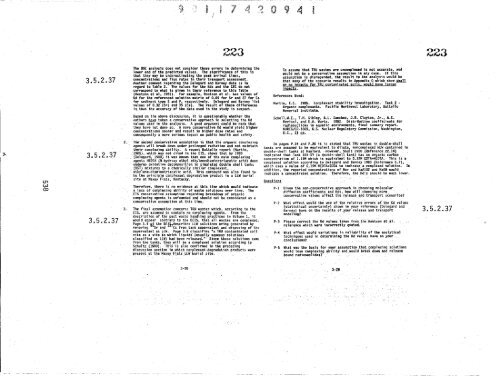EIS-0113_Section_11 - Hanford Site
EIS-0113_Section_11 - Hanford Site
EIS-0113_Section_11 - Hanford Site
You also want an ePaper? Increase the reach of your titles
YUMPU automatically turns print PDFs into web optimized ePapers that Google loves.
P<br />
!.<br />
223 223<br />
The DOE analysis does not consider those errors in determining the<br />
lower end of the predicted values. The significance of this is<br />
that they maybe underestimating the peak arrival times,<br />
concentrations and flux rates in their transport assessment.<br />
3 ' S . 2 ' 3<br />
Another co mm ent regarding the Delegard and Barney data is in<br />
regard to Table 2. The values for the He and the CEC do not<br />
correspond to what is given in their reference to this Table<br />
(Routson at al l 1981). For example, Bentsen at al. has values of<br />
Kd for the referenced solution matrix of 0.09 for Sr and 27 for Cs<br />
for sediment type 5 and P, respectively. Delegard and Barney list<br />
values of 0.32 (Sr) and 35 (Cs). The result of these differences<br />
is that the accuracy . of the data used in the study is suspect.<br />
Based on the above discussion, it is questionable whether the<br />
authors have taken a conservative app roach in selecting the Kd<br />
values used in the analysis. A good .argument could be made that<br />
they have not done so. A more conservative Kd would yield higher<br />
concentrations sooner and result in higher dose rates and<br />
consequently a more serious impact on public health antl safety.<br />
To assume that TRU wastes are uncomplexed is not accurate, and<br />
would not be a conservative assumption in any case. If this<br />
assumption is disregarded, the result to the analysis would be<br />
that many of the scenario results in Appendix q which Show small<br />
or no o<br />
n e<br />
imoactSm<br />
References Used:<br />
Martin, E.C. 1985. Complexanf stability investigation. Task 2 -<br />
Organic complexants. Pacific Northwest Laboratory, Battelle<br />
Memorial Institute.<br />
Schell ,W.E., T.H. Sibl my, A.L. Sanchez, J.R. Clayton, Jr., A.E.<br />
Nevissi, and E.A. Wertz. 1982. Distribution coefficients for<br />
radionuclides in aquatic environments, final su mm ary report.<br />
NUREG/CR-1869, U.S. Nuclear Regulatory Co mm ission, Washington,<br />
D.C., 21 pp._<br />
CT<br />
co<br />
2. The second conservative assumption is that the organ"c complexing<br />
on pages P.2A and P.26 it is stated that TRU wastes in double-shell<br />
agents will break down under .prolonged radiation and not maintain<br />
Yanks are assumed to be equivalent to dilute, noncomplexetl HIM contained in<br />
their complexing ability. no 0 te A recent Battelle report (Martin,<br />
double-shell tanks at <strong>Hanford</strong> However, Shulz 1960 (Reference 22.14<br />
3 .5.O 37 985), which was not cited in the E18, shows that . by 1980<br />
L J<br />
indicated that Tank 101-SY (a double-shell tank) has an organic carbon<br />
(Delegard, 1980) At was known that one of the main complexion concentration of 1.19M which is equivalent to 0.12MEDTA+HEDTA This is a<br />
agents HEDTA (N-hydroxy ethyl. ethylenediammetri acetic acid). does<br />
complexed solution accerding to Deleoard and Barney 1983 (Reference 5.7),<br />
undergo oxidative decomposition in simulated double shell. tanks<br />
which uses a value of 0.15M HEDTAtEDTA to indicate a complexed solution. In<br />
(DST) mixtures to a chemically similar complexant,<br />
addition, the reported concentrations of Nat and NaAlo? and NaGHwould<br />
ethylene d amrnetri acetic acid. This compound was also found. to<br />
indicate a concentrated. solution. Therefore, the Kd's should be much .lower.<br />
_ be the principle complexant degradation p roduct in a LLW burial<br />
site at Maxey Flats, Kentucky.<br />
Ouestlnn5<br />
Therefore, there is no evidence at this time which would indicate<br />
a loss of complexing ability of waste solutions over time. The<br />
ITS conservative assumption regarding breakdown of .organic<br />
complexing agents is unfounded and should not be conside re d as a<br />
conservative assumption at this time.<br />
P-1 Give the on-conservative. approach in choosing molecular<br />
diffusion coefficients and Kds, how Will <strong>11</strong> choosing more<br />
cdnservat i ve values affect the release and oo sin gomo scenarios}<br />
P-2 What effect would the use of the .relative errors of the Ktl values.<br />
(statistical uncerta in ty) shown in your reference (Delegard and<br />
3. The final assumption concerns TRU wastes which, according to the Barney) have on the re sults of your release and transport<br />
<strong>EIS</strong>, are assumed to contain no. complexing agents. From the<br />
modeling?<br />
description of the past waste handling practices in Volume. 1, it<br />
would appear contrary to the D<strong>EIS</strong>, that all wastes are complexed.<br />
3.5.2.37 p_3 Please correct the Uvalues taken from the Bentsen at al.<br />
Page. 3.4 the{^ DE ] tl escribes LLW solutions being generated by<br />
Q^<br />
reference which were incorrectly quoted.<br />
removing Sr and Cs from tank supernatant and disposing n ami of the<br />
supernatant as LIN. Page 3.9 (usu.... contaminated uti soil<br />
p.a What effect would variations an reliability of the analytical<br />
site as a to Which<br />
(usuall<br />
so<br />
beenrx liquids ally y aqueou s solutions<br />
techniques used in determining the Kd values have on your<br />
classifieds<br />
had released.' Since these solutions came<br />
conclusions?<br />
from the tanks, they ,will be a o oil ma d solution according to<br />
" Schultz (1980) This in also coonil in the preceding p.5 What was the hales for your an that complexing solutions<br />
d iscussion sectio n which pomplea siteradatl on products were<br />
would lose complexing ability ity and woulld Would break down and release<br />
present at the Maxey Flats LLW burial site.<br />
bound radionuclides?<br />
3.5.2.37<br />
3-283-29

















